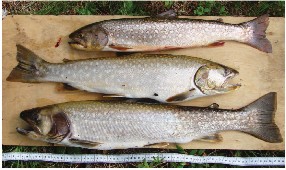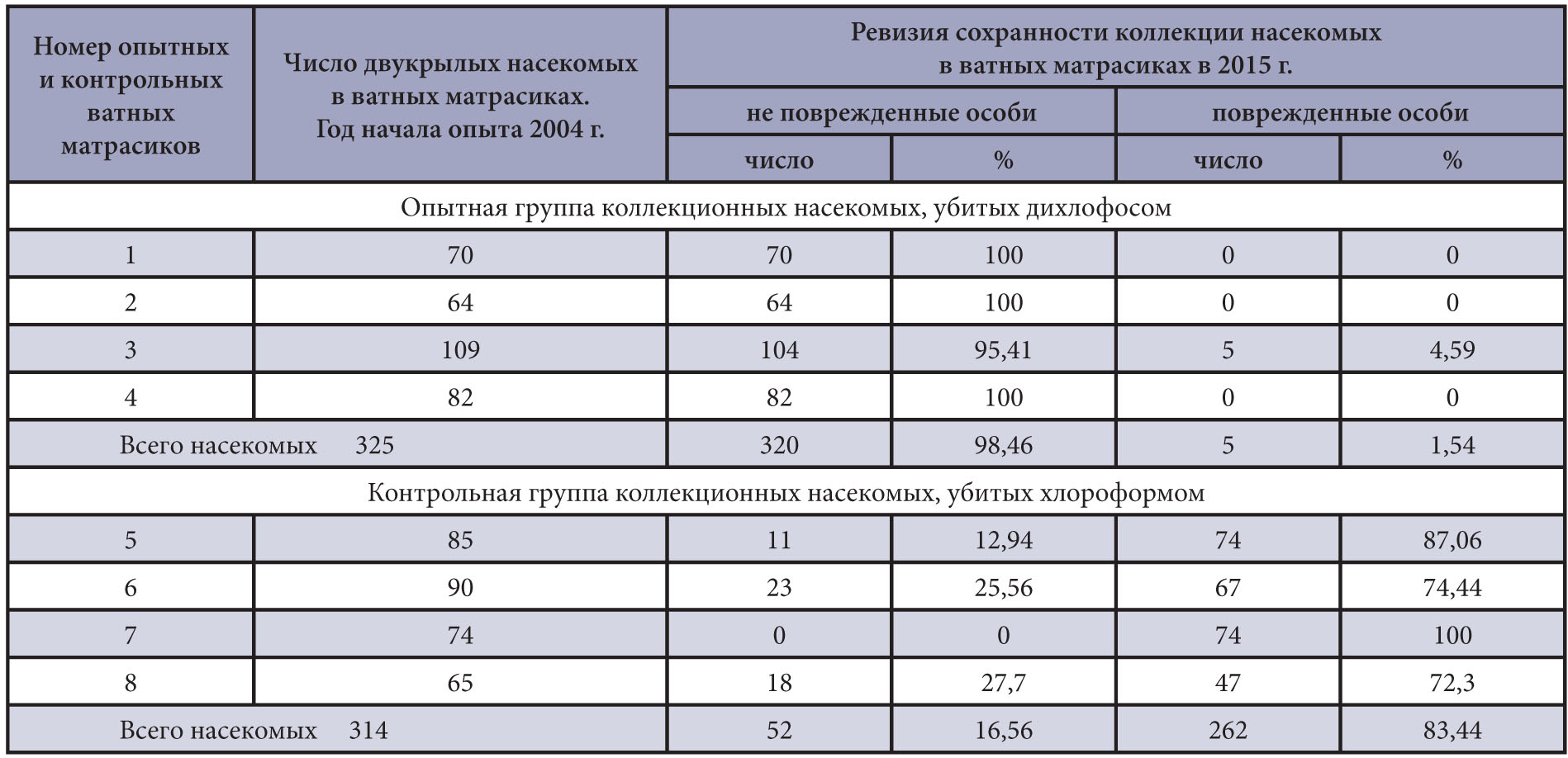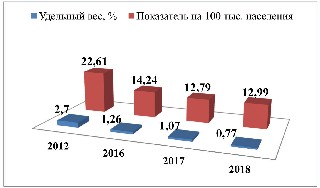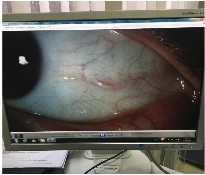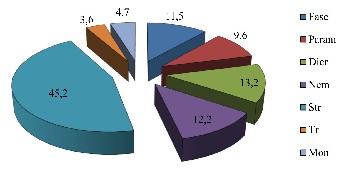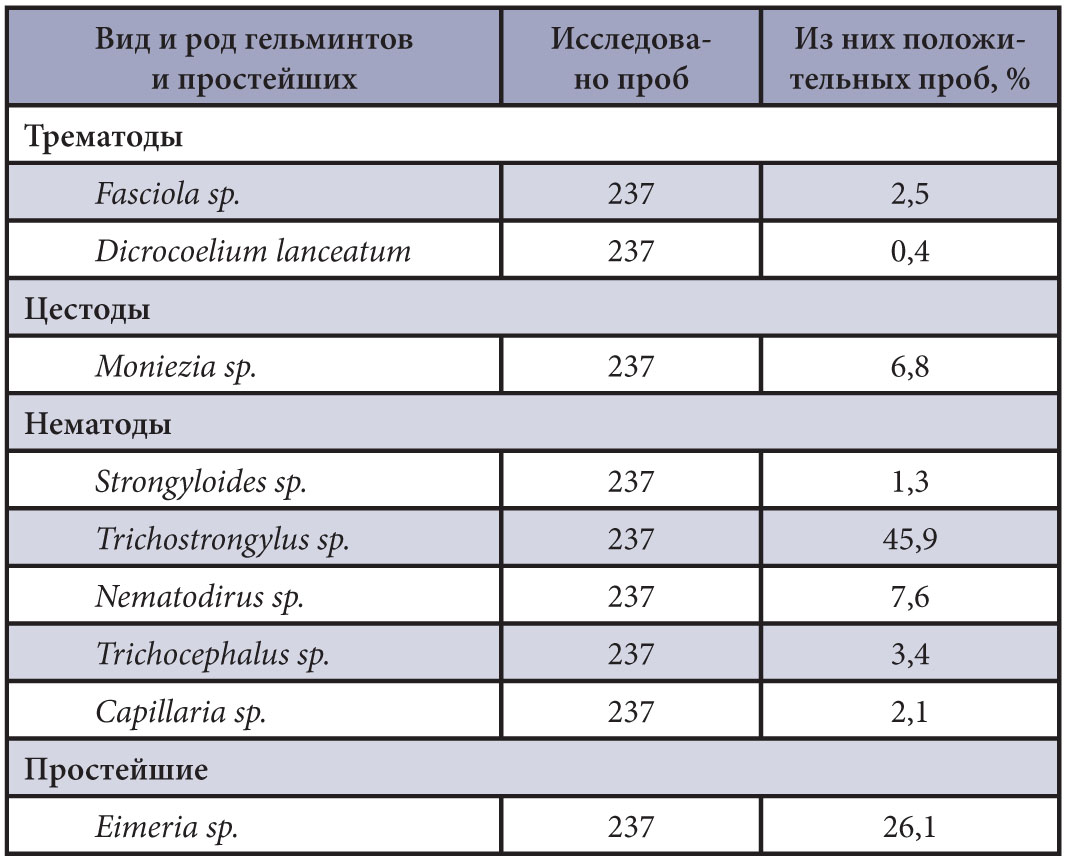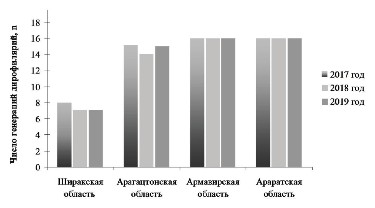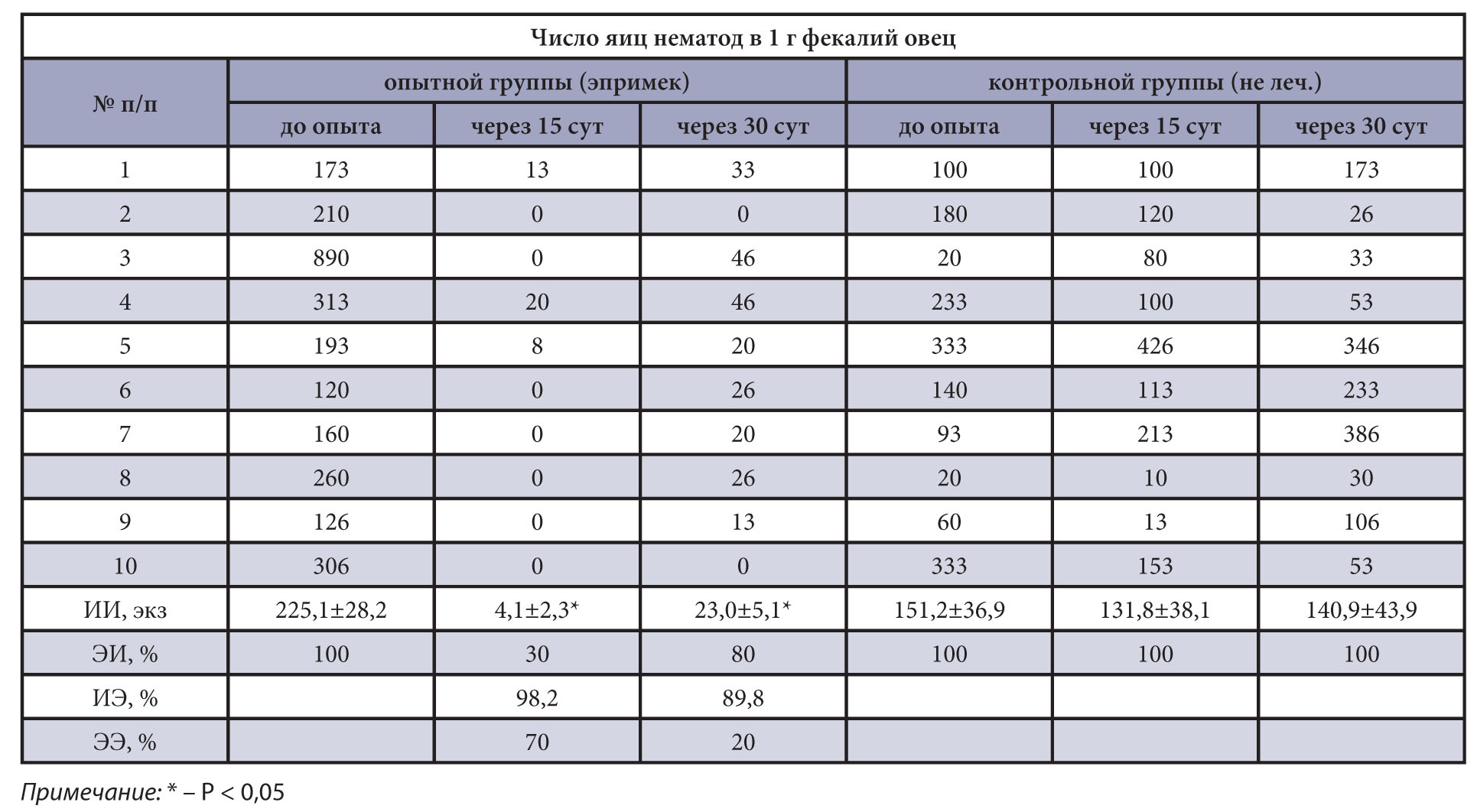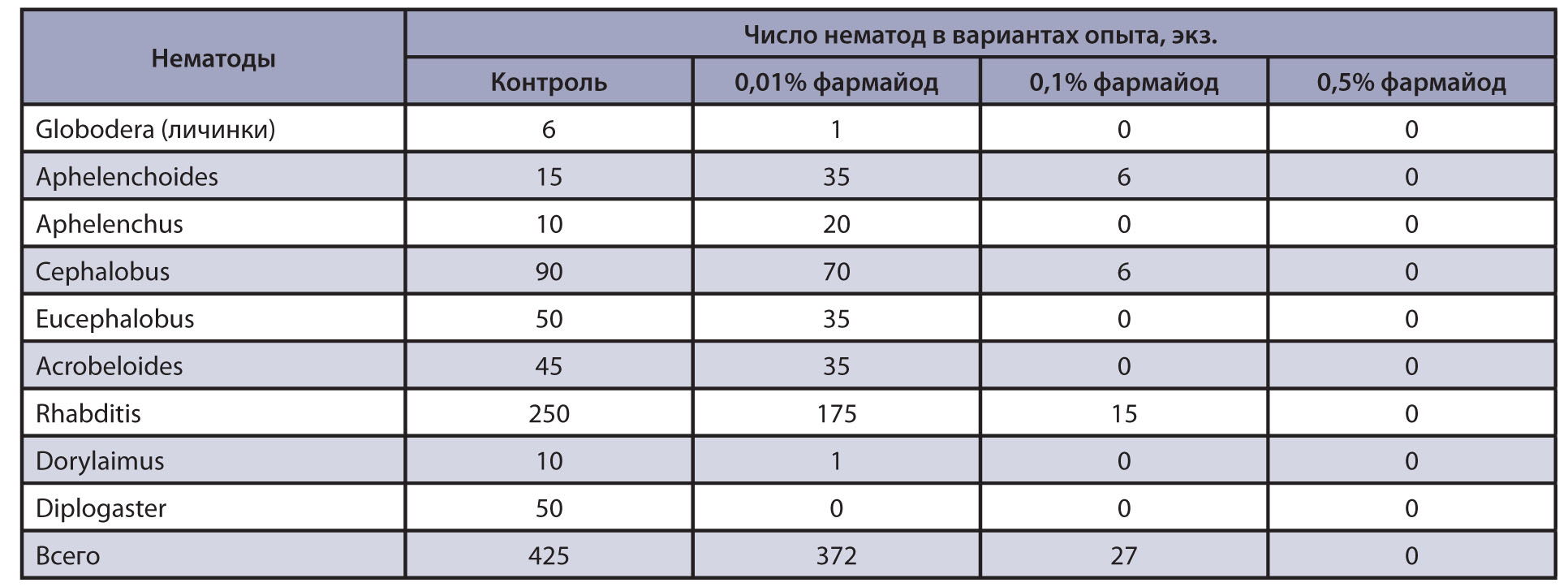FAUNA, MORPHOLOGY AND SYSTEMATICS OF PARASITES
The purpose of the research is studying current fauna of helminths in wild artiodactyls and analysis of their ecological relationships with populations of representatives of the Artiodactyla in biogeocenoses of Karakalpakstan.
Materials and methods. Wild populations of artiodactyls were studied in 2016–2020 in the ecosystems of the Kyzyl Kum, Ustyurt and the lower reaches of the Amu Darya, including the drained bottom of the Aral Sea. Some killed animals (the saiga, Persian gazelle, and Bokharan deer) seized from poachers, as well as those killed by predators and feral dogs in the sanctuaries and reserves of Karakalpakstan were used to collect helminthological material. Wild boars were examined after shooting during the hunting season. A total of 11 saigas, 13 Persian gazelles, 7 Bokharan deer and 16 wild boars, and 213 fecal samples from these animals were examined. The studies were carried out using generally accepted methods of dissection (Skryabin, 1928; Ivashkin et al., 1971) and ovoscopy of animal feces. For a comparative analysis of helminth fauna of the study animals, we used previously collected (1959–1978) parasites from the wild boar, saiga, Persian gazelle and Bokharan deer in Karakalpakstan.
Results and discussion. We have found that the fauna of the Artiodactyla is represented by the following 5 species in the biogeocenosis of Karakalpakstan: Sus scrofa nigripes Blan., Cervis elaphus bactrianus Lydek., Gazella subgutturosa Gueld., Saiga tatarica Linn., and Ovis orientalis arcal Gmel., in which we identified 26 helminth species classified as Cestoda, Trematoda and Nematoda. Cestodes are represented by 6 species, trematodes by 2 species, and nematodes by 18 species. The helminth species composition of the study animals is 14 species in pigs, 11 species in Bokharan deer, 13 species in saigas and 14 species in Persian gazelles. Representatives of the genera Taenia, Echinococcus, Fasciola, Schistosoma, Gongylonema and Setaria are common to these animal species. By nature of the biological cycle, the helminths of the study artiodactyls recorded by us can be divided into two groups: monoxenous and heteroxenous. Monoxenous parasites include representatives of the Trichocephalidae (3 species), Trichostrongylidae (2 species), Dictyocaulidae (2 species), Syphaciidae (1 species), and Ascarididae (1 species), whose life cycles proceed without changing hosts. Eighteen species of representatives of cestodes (6 species), trematodes (2 species) and nematodes (10 species) are developed with the involvement of intermediate hosts.
ECOLOGY AND BIOLOGY OF PARASITES
The purpose of the research is studying the relationship between nematodes of the genus Philonema (Philonemidae) and salmonids at the organismic level and justification for their interpretation as a peculiar form of encapsulation.
Materials and methods. We studied the sockeye salmon, as well as the freshwater white-spotted char and Dolly Varden trout from lakes Kisi and Chistoye (basin of the Ola River, Taui Bay, Sea of Okhotsk). 7 males for breeding sockeye salmon, 39 freshwater white-spotted chars and 16 Dolly Varden trouts were dissected for infection by Philonema. We used well-known generally accepted techniques in the parasitological studies. The nematodes were preserved in 70 % ethanol and clarified in glycerol.
Results and discussion. Phylonema causes pathological processes of various intensity in the body cavity of salmonids. As a rule, this is the adhesion of fish’s internal organs and the formation of a thick layer of connective tissue that surrounds the host's organs from outside and forms a kind of a "cocoon". Our studies combined with literature data allow us to consider the formation of a "cocoon" as a peculiar form of encapsulation and an adaptation that minimizes mutual negative impact of the parasite and the host on each other. Further research should determine how widespread this form of encapsulation is in nature, and it is also necessary to study the mechanism of the "cocoon" formation.
EPIZOOTOLOGY, EPIDEMIOLOGY AND MONITORING OF PARASITIC DISEASES
The purpose of the research is development of a method for long-term preservation of collectible insects in cotton mattresses and entomological boxes against pests.
Materials and methods. The work was carried out in 2004–2019. The patent search was carried out in accordance with the task and search rules. There are enough literary sources and titles of protection found on the problem under study. Experimental studies have been carried out to develop a method that ensures long-term preservation of collection insects in cotton mattresses and entomological boxes against pests.
Results and discussion. An entomological killing jar has been developed to ensure long-term preservation of collectible insects. The result is achieved by the fact that insects death occurs slower in the killing jar than in the killing jar with ether or chloroform, which allows the organophosphate insecticide with a long residual effect to fumigate through the respiratory trachea into the insect's body and dissolve in the fat body, hemolymph and muscles. Collection insect's body becomes completely poisonous to pests. It ensures long-term preservation, repellency and insecticidal properties of the insect’s entomological museum.
The purpose of the research is analyzing literature sources to establish the role of opisthorchosis in health care and assessing the relevance of histological and histochemical methods in determining the efficacy of drugs against helminths which are causative agents of opisthorchosis.
Materials and methods. We analyzed literature sources on the study of opisthorchosis, its pathogen spread and its significance for public health. We also reviewed the official documentation of the annual reports presented on the official websites.
Results and discussion. In 2018, more than 19.0 thousand cases of opisthorchosis were recorded in the country (rate is 12.99 per 100 thousand population), which made up 79.5% of all recorded bio-helminthosis in the population. Opisthorchosis is characterized by long course and proceeds with frequent exacerbations. The most serious complication is cancer in the liver, bile ducts and pancreas, which are organs of opisthorchis parasitism. The works of many authors reveal the connection and high incidence of cholangiocarcinoma in patients with opisthorchosis in countries with endemic sites of Opisthorchiidae family representative’s infection. Long-term opisthorchosis infection reduces the efficacy of anthelmintic therapy and leads to the appearance of the disease recurrent forms. Opisthorchis viverrini was officially recognized as a Group 1 biological carcinogen by the International Agency for Research on Cancer in 2009. The carcinogenic role of O. felineus has not yet been sufficiently studied. However, life cycles, morphology and localization in the human body of O. viverrini and O. felineus are similar. In the list of established medicinal products with opisthorchocidal action, special attention and interest are paid to herbal products. Histological and histochemical research methods confirmed the efficacy against such herbal preparations as ecorsol, erlim and artemisin.
the purpose of the research is monitoring population and species composition of common blood-sucking ectoparasites of the Kaluga Region, mosquitoes and ixodid ticks, and parasitic zoonoses, in the circulation of which they are involved.
Materials and methods. The records were made in all districts of the Kaluga Region and in the city of Kaluga. We studied open meadow-field and forest-shrub stations, closed meadow-field and near-water stations, and settlement stations. The species was identified using the atlases of ixodid ticks by I. M. Ganiev, A. A. Aliverdiev (1968) and V. N. Shevkoplyas (2008), and the guidance of R. M. Gornostaeva (1999). The situation with transmissible parasitic zoonoses in the Kaluga Region was assessed based on the analysis of information from open sources of the Hygienic and Epidemiological Center of the Kaluga Region and the Veterinary Committee under the Government of the Kaluga Region.
Results and discussion. There are two species of ixodid ticks in the Kaluga region: Ixodes ricinus and Dermacentor reticulatus. The abundance index of ixodid ticks of the species I. ricinus is 16.8±1.32 individuals per 1 flag-hour in forest biotopes, and 11.6±1.12 individuals per 1 flag-hour in meadow biotopes, and the abundance index of D. reticulatus is 10,8±1.14 and 15.9±1.30 individuals per 1 flag-hour, respectively. Three mosquito species prevail, namely, Stegomya communis, S. vexans, and Culex pipiens. The maximum number was 8 thousand per 1 m3. During the study period, the causative agent of infectious tick-borne borreliosis was found on average in 10.6% of ixodid ticks collected from humans and in 13.2% of ticks collected in natural biotopes. The causative agent of human granulocytic anaplasmosis was isolated on average in 3.1% of ixodid ticks collected from humans and 6.4% of those collected in natural biotopes. Infection rate for I. ricinus ticks infected with pathogen of infectious tick-borne borreliosis was 16.9%, and D. reticulatus 12.3%.
The purpose of the research is studying environmental objects contaminated with Taeniidae eggs, and egg stability and viability in soil and feed supplies in the mountainous zone of the North Caucasus.
Materials and methods. The studies were carried out in the mountainous zone of the North Caucasus in 2016–2019 at the laboratory of infective diseases of animals and birds of the Caspian Zonal Research Veterinary Institute. We examined 200 samples of dog feces, 3,600 soil samples and 1,000 samples of different types of food for Taeniidae eggs at altitudinal belts of 1000, 1500, 2000, 2500, 3000 and 3500 m above sea level in winter, spring, summer and autumn using conventional methods. Experiments were also carried out to determine the viability and possible overwintering from November to March of Echinococcus granulosus eggs at an altitude of 1,000, 1,500, 2,000, 2,500, 3,000 and 3,500 m above sea level. In order to study the sanitary state of infrastructure facilities of the mountainous zone for contamination with Taeniidae eggs, we studied 300 soil samples from near-village pastures, distant pastures, rural households, near-shed areas, shelters, near watering stations, along the sides of mountain rivers, and in places of daytime rest of sheep and cattle in pastures using the methods generally accepted in helminthology. We studied possible survival in the winter of Taeniidae eggs in external environment in samples of feces, soil, after-grass, hay, silage and compound feed from November to March. After winter, Taeniidae eggs were examined by coproovoscopy methods. The data were processed by statistical methods according to N.A. Plokhinsky (1978).
Results and discussion. It was found that temperature fluctuations of 13.4 to 25.8 ºС in spring and summer seasons in the mountainous zone had a more favorable effect on cestode egg preservation and development. Eggs became invasive in 8–10 days in June and August. The maturation of E. granulosus eggs to the invasive stage was observed in 13 days in September (20.5 ºС), and in 22 days in November (8.3 ºС), which was associated with a decrease in ambient temperature. In dynamics, soil contamination with E. granulosus eggs in the Dagestan mountainous zone in 2016–2019 was characterized by an annual increase in soil contamination with eggs. The soil contamination rate with Taeniidae eggs increased from 63.00% to 88.00% (mean 80.50% of samples). In Dagestan, there is a deterioration in sanitary state of soils of infrastructure facilities as indicated by an increase in Taeniidae eggs in 4–5 g of soil from 7.60±0.40 to 19.30±1.10 eggs (mean 12.30±0.70 eggs). The soil of all studied infrastructure facilities was almost 100% contaminated with Taeniidae eggs. At biological sites, at an altitude of 1,000, 1,500, 2,000, 2,500, 3,000 and 3,500 m above sea level, there were 26.30% 19.84%; 12.55%; 8.0%; 4.99% and 0% of E. granulosus eggs viable in March, respectively. E. granulosus eggs do not survive the winter at an altitude of 3,500 m in March. The study of the possibility of E. granulosus eggs to overwinter showed that the eggs kept in after-grass, silage, hayand compound feed samples during the winter retained viability in the amount of 37.30%, 74.30%, 81.70% and 92.40 % respectively. In case of sanitary requirements violated during grazing, procurement and storage, the aftergrass, silage, hay and compound feed contaminated with Taeniidae eggs are factors for ensuring preservation and viability of invasive elements and continuous implementation of an epizootic process of taeniidosis in populations of ruminants..
The purpose of the research: is to conduct a comparative assessment of the infection of cattle with helminths and the structure of helminthic complexes in various natural provinces of Gorny Altai.
Materials and methods. Coproovolarvoscopic examinations of about 2.4 thousand of cattle from various farms of the Altai Republic were carried out. Based on their results, the animal’s infection (the prevalence of infection, PI, %) with helminths in various natural provinces was characterized. The structural indices of various taxa of helminths (SI) have been calculated, which reflect their weight in the structure of the parasite complex.
Results and discussion. Cattle in the Altai Republic are mostly infected with nematodes (51.4%). The indicators of the animal infection with trematodes and cestodes were significantly lower and amounted to 17.4 and 5.2% respectively. Nematodes dominate in the structure of animal helminthocenosis in various provinces. Their total SI varies from 66.8 to 76.8. The classes of trematodes and cestodes account for 8.8–26.3 and 4.5–14.4 respectively. The maximum SI was registered in Strongylata of the digestive tract (45.2), the subdominant position is occupied by trematodes: Dicrocelium sp. (SI – 13.2) and Fasciola hepatica (SI – 11.5). Moniezia sp. SI was quite low and amounted to 4.7.
The purpose of the research is studying the distribution of endoparasitoses in bison in various regions of the Russian Federation.
Materials and methods. The endoparasite fauna in bison was studied in 2018–2020 in the FSBI Prioksko-Terrasny Nature Biosphere Reserve (Moscow Region), the Bison Nursery of the Siberian Branch of the Russian Academy of Sciences of the Altai Republic, the Bryansk Forest Nature Reserve (Bryansk Region), the Ugra National Park (Kaluga Region), the Vologda Region, and at the Department of Parasitology and Veterinary and Sanitary Expertise of the Moscow State Academy of Veterinary Medicine and Biotechnology – K. I. Skryabin MVA. We studied feces collected from bison of different sex and age groups near feeders in the runs, and in reserves, nurseries and in the wild. A total of 320 samples were collected and examined including 237 samples from the Prioksko-Terrasny Nature Biosphere Reserve, 15 samples from the Bison Nursery, 18 samples from the Bryansk Forest Nature Reserve, 29 samples from the Ugra National Park and 21 samples from wild bison from the Vologda Region. For helminth-coprological studies, we collected fresh feces of bison from the soil surface. The feces were examined according to generally accepted methods. The sequential washing technique was used to diagnose trematodiases, and the Kotelnikov-Khrenov and Fulleborn flotation methods were used to diagnose cestodoses, nematodoses and eimerioses.
Results and discussion. The endoparasite fauna of the European bison was most diverse in the Prioksko-Terrasny Nature Biosphere Reserve, where we identified the parasitizing of two species of trematodes, one genus of cestodes, one species and four genera of nematodes and one genus of protozoa. All these pathogens parasitize both as mono- and mixed infections. One species of trematodes, one genus of nematodes and one genus of protozoa have been identified in the Ugra National Park. One genus and two genera of nematodes were found in the Bison Nursery of the Siberian Branch of the Russian Academy of Sciences of the Altai Republic and in the Bryansk Forest Nature Reserve, respectively. The dominant were gastrointestinal strongylatoses.
The purpose of the research is to study the possibility of using the temperature DDU (dirofilaria development units) model for predicting the spread of dirofilariosis in dogs in various regions of the Republic of Armenia.
Materials and methods. To obtain temperature models of dirofilariosis in various regions of Armenia, the method of mathematical modeling was applied. The method for determining the number of generations of Dirofilaria spp. infection is based on the effect of the average daily air temperature on the rate of development of Dirofilaria larvae in mosquitoes with a threshold of 14 °C. For a negative value of DDU, the value is set to zero. At temperatures above the threshold, DDU accumulate. For the development of larvae to the infective stage, an amount of 130 DDU is required. The number of possible generations of one generation of larvae L3 was calculated by dividing the annual sum of temperatures above 14 °C by 130 DDU, taking into account that 130 DDU should accumulate within a period not exceeding 30 days. The calculation uses daily data on the average daily air temperature in the period from 2017 to 2019 for Shirak, Aragatston, Armavir and Ararat regions of Armenia.
Results and discussion. Temperature modeling of DDU is not of high significance, since it takes into account only the average daily air temperature and does not take into account other factors affecting the incidence rates. The largest number of generations of larvae in mosquitoes could be realized in the Armavir and Ararat regions – on average, 16 generations per year. At the same time, the infection of dogs with dirofilariae in the Armavir region was 42.8%, and in the Ararat region – 29.6%. In Aragatston region, on average, 14–15 generations are developing per year. Dirofilariosis was not detected in the studied dogs. In the Shirak region, on average, 7–8 generations are developing per year. Dirofilariae infection was detected in 3.6% of the dogs studied. Based on the temperature DDU-model of dirofilariosis (on the dates of the end of the first and last incubation of dirofilariosis larvae in mosquitoes for several years), as well as the results of phenological observations, we have developed schemes for effective prevention of dirofilariosis. In order to organize and conduct veterinary preventive measures to prevent infestation of dogs by dirofilariae, it is necessary to organize two lines of defense. The first line of defense: the use of anthelmintics from the group of macrocyclic lactones in Aragatston, Armavir and Ararat regions, which is carried out monthly, and in the Shirak region - from April to January. The second line of defense is repellant treatment of dogs in the Aragatston, Armavir and Ararat regions from March to November, and in the Shirak region from April to October. The practical application of temperature DDU-models of dirofilariosis allows specialists of veterinary and sanitary services to establish the timing of the epizootic season of dirofilariosis, as well as organize and conduct veterinary preventive and therapeutic measures among the population of dogs in endemically disadvantaged areas of the republic.
PHARMACOLOGY, TOXICOLOGY
The purpose of the research is assessment of karyopathic effect and general safety of Trichinella spiralis and Echinococcus multilocularis protein extracts in mice.
Materials and methods. To assess the karyotic effect bone marrow cells were isolated and preparations were prepared using a metaphase method (Ford C. E., Hamerton J. L., 1956). Cytological analysis of bone marrow smears was performed to determine the white cell lineage counts. The main hematological indices of mice were determined at hematological analyzer «Abacus JuniorVet» («Diatron», Austria); differential white blood cell count was analyzed using common method. Blood biochemical indices were determined at biochemical analyzer A-15/25 (BioSystems S.A., Spain).
Results and discussion. The intraperitoneal administration of T. spiralis and E. multilocularis protein extracts induced K-mitosis in mice bone marrow cell population. Systemic disorders associated with that cytogenetic effect and general reaction of organism to administration of protein extracts, in particular changes in bone marrow white cell lineage counts and peripheral blood indices were revealed. T. spiralis and E. multilocularis protein products showed some negative effects on liver and kidney function in mice.
TREATMENT AND PREVENTION
The purpose of the research is studying the efficacy of Eprimek (Eprinomectin) against gastrointestinal nematodes in sheep.
Materials and methods. A commercial experiment to study the antiparasitic efficacy of Eprimek was carried out in June 2020 on 300 lambs of the North Caucasian breed in a private flock of Filimonovskaya Village, Izobilnensky District, the Stavropol Territory, which were divided into two groups. The experimental group of lambs (290 animals) was injected Eprimek subcutaneously at the earset at a dose of 1 ml/50 kg of live weight (10 mg of Eprinomectin in 1 ml), and 10 lambs were not treated; they were used as control. We collected feces from the lambs of the experimental and control groups before administration of the drugs and after 15 and 30 days. Fecal samples were examined by the flotation technique with a saturated solution of ammonium nitrate with counting nematode eggs in 1 g of feces. The results were processed statistically.
Results and discussion. Eprimek showed a decrease in the number of excreted helminth eggs from 225.1±28.2 to 4.1±2.3 in production environment at a dose of 1 ml/50 kg of live weight, according to coprological studies on the 15th day after treatment in the experimental group of lambs. The efficacy was 98.2%, and 70% of the animals were free from the infection. The intensity of infection of the control lambs by gastrointestinal nematodes was 131–151 eggs per 1 g of feces at 100% prevalence.
The purpose of the research is to analyze the economic efficiency of planned antiparasitic deworming in sheep-breeding farms by the veterinary service of the region.
Materials and methods. The studies were carried out using statistical data from the Veterinary Directorate of the Stavropol Territory for 2015-2019 and guidelines for determining the economic efficiency of antiparasitic measures. Economic losses were estimated at regional purchase prices for livestock products as of 2019. The calculations used indicators such as morbidity, mortality, and specific losses of the main product (meat, wool) per sick animal. The economic efficiency of veterinary measures for parasitic diseases of sheep was determined by the indicator of the prevented economic damage.
Results and discussion. Analysis of the results of the treatment of sheep by the veterinary service of the region over a five-year period for the prevention of parasitic diseases showed that they annually carry out a large amount of antiparasitic treatments, but it should be noted that their number for all infestations decreased in 2019 compared to 2015 from 10180.0 thousand to 5231.0 thousand. Actual economic damage from parasitic diseases amounted to 10343.5 thousand rubles, and the amount of economic damage prevented as a result of planned deworming of sheep was 3.6 times higher than the amount of actual economic damage and amounted to 37895.7 thousand rubles.
The purpose of the research is to study the possibility of Pharmaiod application for golden potato nematode (GPN) decontamination in soil.
Materials and methods. The object of research was GPN population recovered with soil from the APF "Russia", Vladimir Region. Tubers of susceptible potato cultivar Sineglazka (hybrid 15555) were used. Experiment to evaluate treatment effects and rates of experimental powder and liquid forms of Pharmaiod was carried out in pots by biotesting.
Results and discussion. The obtained data showed that GPN larvae in soil samples died post application of powder form of Pharmaiod at dose level of 0.5% and 1%. Following application of 0.1% Pharmaiod alive GPN larvae were found in separate cysts. Pharmaiod liquid form significantly reduced the number of GPN females on roots (biological efficiency - 96%). Liquid form (at dose level of 0.5% and 0.1%) and powder form (0.1%; 0.5%; 1%) of Pharmaiod appeared to be phytotoxic: the tubers did not germinate and did not form a root system.
The purpose of the research is to study the ovocidal properties of four samples of polyaminol disinfectant at different concentrations in vitro experiment.
Materials and methods. Test object: eggs of the nematode Toxocara cati, obtained from the end sections of the prepared uterus of fertilized female helminths. The work consisted of two stages: preparing a culture of T. cati eggs and studying the ovocidal properties of the samples and the concentrations of polyaminol compared to the base preparation phenol in laboratory.
Results and discussion. Under the influence of different concentrations of polyaminol No. 1, the number of dead eggs of T. cati and the efficiency ranged from 75 to 99%. The ovocidal effect of different concentrations of polyaminol No. 2 ranged from 60 to 93%, and of polyaminol No. 3 sample – from 37 to 86%. Polyaminol No. 4 at a tested concentration of 0.2% provided a 100% ovocidal effect. Phenol 4% used as a base preparation under laboratory conditions showed high intensity – 100%.
ISSN 2541-7843 (Online)




